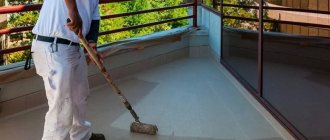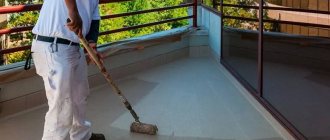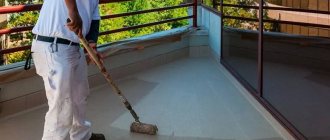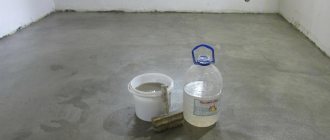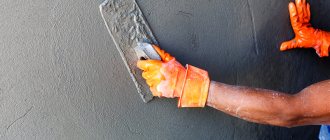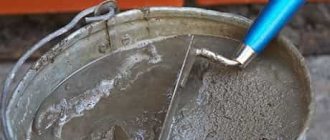Scope of application
- Additional waterproofing - achieved by adding a solution of liquid glass directly to the concrete before pouring. Waterproofing can also be done by applying liquid glass and/or a layer of cement mortar containing it to the finished surface. This method is used to treat storm drains, wells, septic tanks, hydraulic structures, and other structures.
- Increasing acid and fire resistance - the surfaces are carefully primed with a cement mortar prepared using a solution of liquid glass and water. Also, the sodium composition is added directly to the mixture for laying bricks (relevant when creating fireplaces and stoves).
- Bonding materials - liquid is used in its pure form when working with cardboard, glass, porcelain. Composite mixtures are also used to fill voids and cracks in structures.
- Impregnation of structures and materials - applying an aqueous solution with liquid glass allows you to strengthen weak concrete and plastered surfaces (floors, walls). The composition is applied in 2-3 layers to achieve the best result.
- Antiseptic treatment is relevant for wooden structures. They are thoroughly coated with liquid glass diluted with water. This protects against the effects of dampness and the development of fungal lesions.
Important! Any type of liquid glass significantly accelerates the hardening of the mortar. It is recommended to mix small batches that can be mixed within 30 minutes of preparation.
Volumetric floor
A type of liquid glass waterproofing is a coating technology with a 3D effect. To obtain a three-dimensional image, apply 3 layers:
- base polymer layer;
- drawing or photograph made on banner fabric;
- final polymer layer 3-4 mm thick.
The volume of the image depends on the height of the last layer, but it is not recommended to apply it more than 4 mm. The service life of glass coating with 3D effect is more than 10 years. It is very durable and resistant to mechanical stress.
Features of working with liquid glass: proportions, rules for preparing the mixture
How to properly add liquid glass to a mortar or concrete mixture is a question that needs to be dealt with before starting construction and finishing work. Let's start with the proportions, since they directly depend on the task at hand.
- For filling cracks and voids in walls and partitions. Composition: CEMMIX Liqui liquid glass, cement, sand in proportions 1:1:3. Prepare a mixture of cement and sand, the amount of water is no more than 25% (by weight) of the amount of liquid glass. Add liquid glass to this mixture with constant stirring.
- For priming the screed surface. 14 kg (7 kg) CEMMIX Liqui liquid glass + 14 kg (7 kg) cement. Mix cement with water, the amount of water is no more than 25% (by weight) of the amount of liquid glass. Add in portions to liquid glass with constant stirring.
- For waterproofing wells, septic tanks, storm drains, and hydraulic communications. Coat the walls of the well with liquid glass CEMMIX Liqui, prepare a solution (cement, liquid glass, sifted fine sand in a 1:1:1 ratio, preparation order according to p.l.) and re-seal the well.
- For outdoor work, fire retardant coating, preparation of acid-resistant solutions. Composition: CEMMIX Liqui liquid glass, cement, sand in a ratio of 1.5:1.5:4. Prepare a mixture of cement and sand, the amount of water is no more than 25% (by weight) of the amount of liquid glass. Add this mixture to liquid glass with constant stirring.
- For lubricating wooden parts. Coat walls and ceilings with CEMMIX Liqui liquid glass to create protection against dampness, mold, and mildew.
- Waterproofing treatment of walls in wet rooms (bathrooms, bathrooms). Ingredients: 400 g of CEMMIXLiqui liquid glass, 1 liter of water. Apply the prepared solution to the entire perimeter using a brush or roller.
- Preparation of concrete with water-repellent properties, fire-resistant masonry mortar or mixture for finishing surface treatment - it is recommended to add up to 3% of liquid glass by weight of the batch. At higher concentrations, the surface will become brittle after curing.
- Repair and grouting solutions - it is optimal to add up to 25% of liquid glass from the total mass of the mixture. This recipe will ensure maximum adhesion to the surface.
- Impregnation of wood, priming of concrete - liquid glass is mixed with water in a 1:1 ratio. The resulting mixture can be directly applied to the work surface or used to dilute cement or cement paste to the desired consistency.
Important! For minor repairs and gluing various surfaces, the composition must be used in its pure form. You can read more about recipes using silicates here.
For waterproofing or finishing coating using CEMMIX polypropylene fiber, you can use the following composition:
- 1 part cement CEM II 32.5N;
- 1 part fine washed sand;
- 1 part liquid glass;
- 1 part water;
- polypropylene fibers at the rate of 900 g per 1 m3 of mixture.
It is recommended to carry out a small-volume test batch to determine the ease of working with the mixture. If necessary, you can reduce the amount of water.
The second most important question is how to dilute liquid glass to obtain a homogeneous, high-quality solution. The silicate composition itself has a high viscosity, so in order to be introduced into cement mortar or concrete, it must first be dissolved in water. Otherwise, the silicate will not disperse.
To prepare the solution, take the required volume of clean drinking water (technical water is not recommended) and add a portion of liquid glass with constant stirring. Bring the mixture to homogeneity before combining with cement or CPS.
Safety precautions during operation
The material used is safe and does not contain any harmful elements, but during preparatory or glass coating work itself, alkaline reactions occur when the product comes into contact with exposed areas of the skin.
Therefore, PPE is used during work. Work with rubber gloves and boots.
In the room where the work is being carried out, there should be a container with clean water in case of immediate washing of the skin area if glue gets on it. And the damaged area is treated with a vinegar solution, which acts as an anti-alkaline compound.
How to apply liquid glass and compositions based on it?
When adding liquid glass to a solution, it is important to work quickly and accurately as the mixture begins to set within minutes (the exact time depends on the concentration of silicates). Otherwise, the rules for laying concrete remain classic.
Apply silicate primer only to a dry, clean surface. You must first remove the old paintwork and loose areas of concrete.
The procedure can be repeated only after the previous layer has dried. To apply, use a roller, brush or spray gun (not a sandblaster). Although liquid glass is considered non-toxic, when working with it you should use safety glasses, gloves and a respirator to prevent the composition from entering the body.
Video: Liquid glass on a concrete floor! How to work with it correctly?! Nuances
Important! Keep in mind that other primers, paints, and adhesives do not adhere well to surfaces treated with liquid glass. Think about finishing options in advance.
If we are talking about waterproofing a foundation or other critical surfaces, you can apply liquid glass in its pure form or mixed with water. To protect the waterproofing, apply a mixture of cement, sand and liquid glass (1:1:1). If it is difficult to work with such a composition, first dilute the silicate with water (1:1) and use this solution for the CPS.
Let's sum it up
As a result, it can be noted that liquid glass is an excellent product that makes it possible to obtain a water-repellent layer on different surfaces. In addition, it is fireproof, antiseptic and thermal insulating. The component is in demand to improve the properties of various solutions. When preparing the solution, it is important to observe the proportions of the ingredients and use it promptly so that it does not lose its properties.
Liquid glass is an excellent product that makes it possible to obtain a water-repellent layer on different surfaces.
The most popular area of application is waterproofing various surfaces. The use of liquid glass is possible inside the house due to its harmlessness, but the layer can also withstand external influences, and therefore can be considered universal.
"Pros" and "cons" of using liquid glass for concrete
The advantages of liquid glass include the following properties:
- high adhesion to surfaces;
- increased fluidity of the finished mixture;
- formation of a dense waterproof film;
- low consumption;
- reasonable price.
Important! To fully appreciate the advantages of silicate additives, choose only compositions that comply with GOST 13078-81 “Sodium liquid glass. Technical conditions".
Disadvantages of silicate products:
- not suitable for processing brick walls;
- requires precise adherence to proportions, solution preparation technology, and high application speed;
- preservation of properties is not guaranteed after 5 years of operation.
Flaws
However, among all the advantages, a couple of disadvantages of the product stand out. You can note how quickly the product hardens, which requires the master to use it quickly. This also makes it difficult to understand which areas remain untreated and how much product should be applied to a certain area. Cannot be used for bricks or organic types of materials. It will not be possible to paint a layer of liquid glass.
For these reasons, it is often easier to hire a professional to apply the product. Otherwise, you can waste the component and not get a high-quality surface treatment. But, of course, this is accompanied by expenses for paying for the services of specialists.
You can note how quickly the product hardens, which requires the master to use it quickly.
For waterproofing houses
The most vulnerable places in our homes to moisture and dampness are basements and roofs. To avoid dampness and destruction of the building, it is necessary to carry out waterproofing work. A liquid glass solution is perfect for this. They impregnate walls and ceilings. The composition of waterproof plaster includes cement and sand in a ratio of 1:2.5 with the addition of a 15% solution of liquid glass.
The primer, which contains liquid glass, is highly water resistant and protects the surface well from moisture and fungi. The depth of impregnation, depending on the material, is 5-10 mm.


